
This episode of Lifespan News, presented by Emmett Short, discusses a study showing that the brains of old mice benefit by receiving the blood of young mice.
Heterochronic parabiosis is a well-known aging intervention in mouse studies, and it works. You stitch two mice together so they share blood and, like Highlander, the old mouse absorbs the life force of the younger mouse. It just happens to be one of the more, shall we say, unrealistic procedures for humans.
I don’t see a doctor prescribing you to stitch a toddler to your chest for a few months to smooth out those wrinkles. Plus, that can’t be good for your back.
Welcome to Lifespan News. I’m Emmett Short. Today we’re talking about the most problematic yet perhaps one of the most promising cures for aging, young blood.
New research published in Nature Aging has shown that factors in young blood can improve brain health this time. Studies also showed that factors in old blood, you guessed it, cause harm to young brains. That makes sense. I don’t think anyone is surprised that old blood is not the cure for aging.
In this study, they joined some 3- to 4-month-old mice with some 20- to 22-month-old mice. Mice of the same age were joined as well for a control group.
The goal of this research was to analyze what effects heterochronic parabiosis has on multiple types of brain cells. See, other studies focused mainly on proteins or the proteome, but these researchers were looking at exosomes, lipids, and a bunch of other nonprotein factors. Over 100,000 cells that consisted of 75 different types were analyzed.
Similar to previous papers, they found multiple beneficial and rejuvenative effects on gene expression. The researchers found that 700 of the over 20,000 genes they analyzed had their expression changed. 442 gene expressions were changed in old animals by youthful blood. 155 gene expressions were changed in young animals by old blood.
We don’t know all of the effects and impacts of these gene expression alterations, but based on what the study measured, the overall impact seems to be positive. So, in my view, that means young blood good, old blood bad.
Some of the benefits were:
- better gene expression
- Less senescence
- Improved intercellular communication that encouraged neurogenesis, the formation of new brain cells
One of the main things this paper highlights is the strong, youth-promoting effects of parabiosis on the blood-brain barrier’s endothelial cells. Endothelial cells have such direct and constant contact with blood, which may be why youthful blood has such a strong effect on those cells specifically.
While not all the effect are known, including potential negative ones, here were three main takeaways from this paper:
- Youthful blood has a positive effect on blood vessels
- Parabiosis could make the body process nutrients better, break down proteins more efficiently, and reduce aging-related cell death.
- There may be new ways to slow brain aging and promote regeneration without targeting specific diseases or factors in the blood.
I’d like to again point out here are all benefits to the older mouse. I’m sure the younger mouse benefited from the wisdom passed down from the older mouse during their time as conjoined twins. But medical benefits were not apparent.
But, what if it’s possible to use a combination of youthful systemic factors along with the blood scrubbing known as plasmapheresis to restore vasculature and function to the aging brain. These studies are helping us figure out some less ethically challenging and technically feasible ways to reverse aging, and more experimentation and eventual human clinical trials will be needed to find out if they work.
When there’s more to share, we’ll have it for you here, so make sure to subscribe to stay up to date! I’m Emmett Short and we’ll see you next time on Lifespan News!
First published in Lifespan.io. You can read the original article here.
If you liked what you just read and want more of Our Brew, subscribe to get notified. Just enter your email below.


Related Posts
Pope Leo Xiv is the First Member of the Order of St. Augustine to Be Elected Pope – but Who Are the Augustinians?
Jun 04, 2025
People Say They Prefer Stories Written by Humans Over AI-generated Works, Yet New Study Suggests That’s Not Quite True
Apr 02, 2025
What are AI Hallucinations? Why AIs Sometimes Make Things Up
Mar 25, 2025